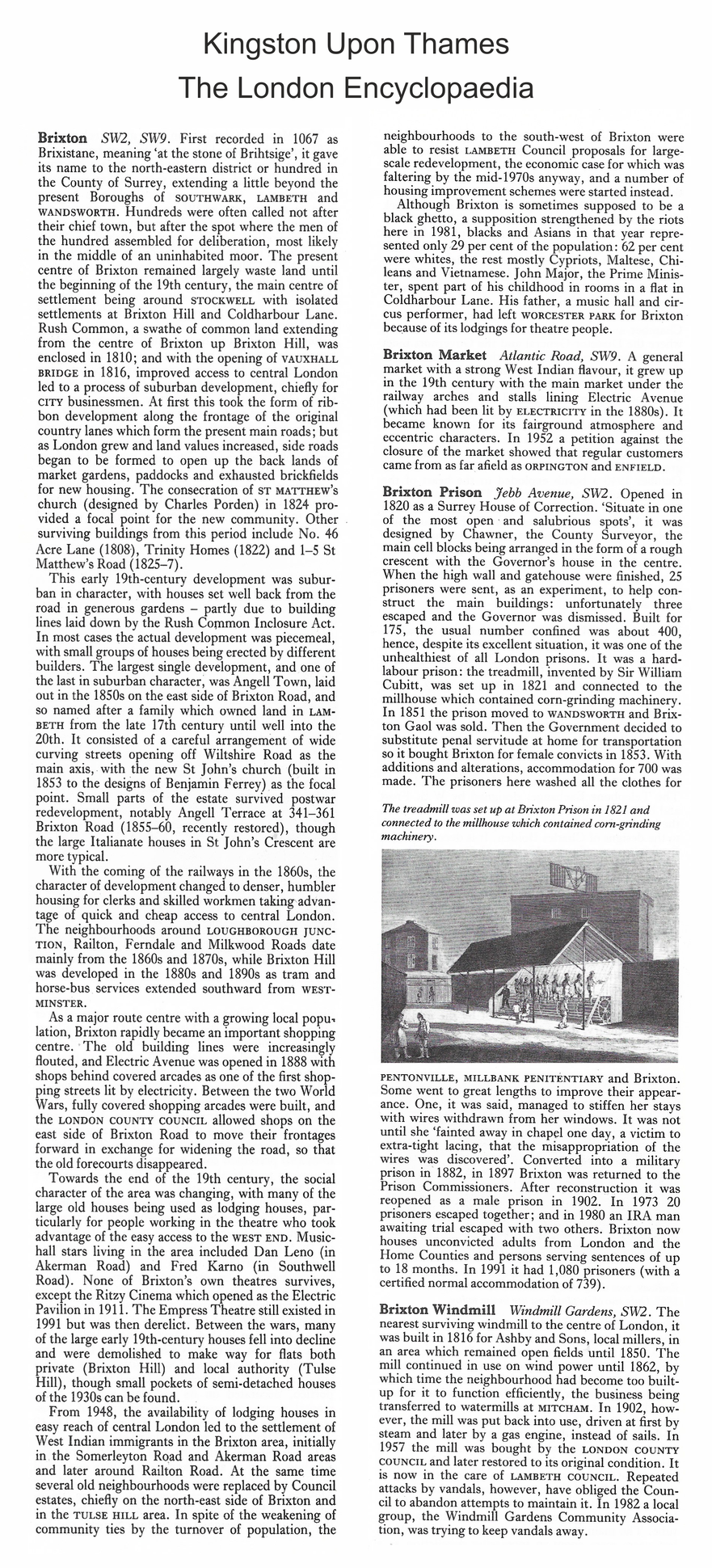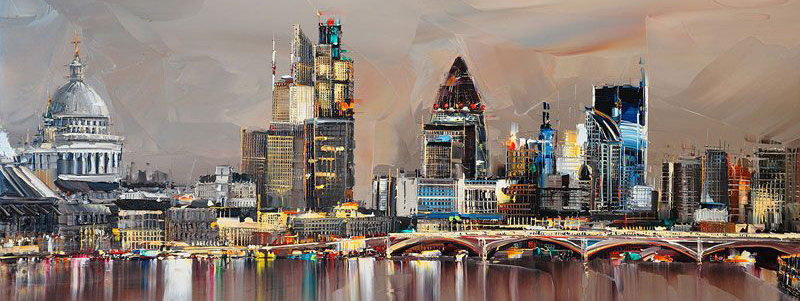Lambeth - South Bank - Vauxall - Clapham - Brixton
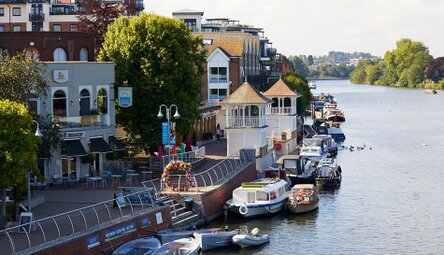 Situated on a slender slice of land, Kingston Upon Thames draws its western boundary from the meandering Thames for a stretch of three miles. This delightful settlement initially sprouted beside a river crossing, its growth spurred by the construction of a bridge. Nowadays, Kingston's busy streets still maintain their medieval layout.
Situated on a slender slice of land, Kingston Upon Thames draws its western boundary from the meandering Thames for a stretch of three miles. This delightful settlement initially sprouted beside a river crossing, its growth spurred by the construction of a bridge. Nowadays, Kingston's busy streets still maintain their medieval layout.Tucked within the town, one finds houses dating back to the medieval period, such as the charming Shell's Bakery, with its façade showcasing timber beams from the 1500s. Located close to the river at number 1, Thames Street stands a house from 1575 that once belonged to a merchant.
Remnants of history are deeply etched in Kingston's fabric, like the traces of pipelines crossing the Thames—ancient conduits installed by Cardinal Wolsey to direct Kingston's fresh spring waters to Hampton Court, just three miles away.
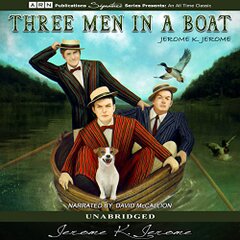 This town has found its way into numerous books, playing backdrop in works by renowned authors such as Wells, D.H. Lawrence, and Jane Austen. It is most famously depicted in "Three Men in a Boat" by Jerome K. Jerome, where Kingston serves as the starting point of a memorable journey.
This town has found its way into numerous books, playing backdrop in works by renowned authors such as Wells, D.H. Lawrence, and Jane Austen. It is most famously depicted in "Three Men in a Boat" by Jerome K. Jerome, where Kingston serves as the starting point of a memorable journey.Adding to the town's character, a row of telephone booths lean precariously in front of the Little Italy restaurant—reminiscent of dominoes ready to topple. This is the work of David Mach, a sculpture from 1988 titled "Out of Order," created as part of the scenic development for the new Relief Road. In the summer, Kingston brims with a variety of interesting festivals. The serene Coombe area lies to the north with its beautiful park, while the elegant Surbiton district unfolds to the south, boasting 19th-century houses and charming Art Deco courtyards. The name 'Surbiton' suggests a 'barn,' reflecting its past of cultivated fields that once nurtured grazing livestock.
Noteworthy individuals have also called this place home; novelist Thomas Hardy lived in St David's Villa on Hook Road in 1870, along with his wife, Emma Gifford. Kingston even made a cinematic appearance —the Surbiton train station was featured in the 2009 film "Harry Potter and the Half-Blood Prince".
THE CHURCH AND THE MARKET
MARKET PLACE
UNDERGROUND: KINGSTON
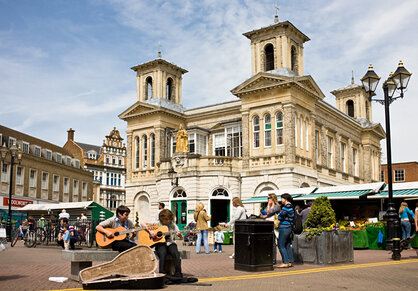 Centrally located, the All Saints Church stands in the market square. Originating from the 12th century, this church hosts a main nave from the 1400s. In 1850, the interior underwent a renovation under the Oxford Movement's influence. Its tower, struck by lightning, used to host a wooden spire. Its bells have chimed for over five centuries, their sound carrying across the years. In the 1988, the church was graced with the installation of a magnificent Frobenius pipe organ. Since this pivotal moment, the church has blossomed into a prime venue for concerts, frequently hosting recitals on Monday lunchtimes. Nestled around it is a quaint garden, adding to the tranquil atmosphere. A small café resides here, where one might partake in homemade muffins and slices of delicious cake—each purchase aiding the missions.
Centrally located, the All Saints Church stands in the market square. Originating from the 12th century, this church hosts a main nave from the 1400s. In 1850, the interior underwent a renovation under the Oxford Movement's influence. Its tower, struck by lightning, used to host a wooden spire. Its bells have chimed for over five centuries, their sound carrying across the years. In the 1988, the church was graced with the installation of a magnificent Frobenius pipe organ. Since this pivotal moment, the church has blossomed into a prime venue for concerts, frequently hosting recitals on Monday lunchtimes. Nestled around it is a quaint garden, adding to the tranquil atmosphere. A small café resides here, where one might partake in homemade muffins and slices of delicious cake—each purchase aiding the missions.The Market Place beats as the heart of this vibrant city. The daily market, funnel-shaped, takes place from Monday to Friday, commanding an important role and maintaining a form of superiority over others. This marketplace tradition can be traced back to at least the 1200s, perhaps even to Saxon times. A striking feature in this bustling centre is the beautiful edifice erected in 1838, once the town
hall, now the welcoming tourist office. The Market Place is accessible through various paths, including the ancient Harrow Passage, named after a pub on Leatherhead Road that still serves patrons today.
GUILDHALL
HIGH STREET
TRAIN: SOUTH WESTERN RAILWAY OR BUS
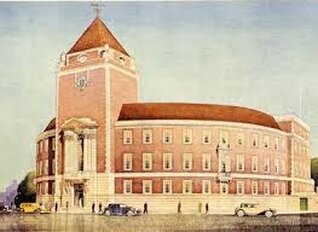 Standing in the heart of the town, a structure designed in 1935 by Maurice Webb, features a rounded form and an imposing tower. Guarded by railings, the courtyard harbours the historic Coronation Stone —allegedly the site where Saxon kings were proclaimed. Surrounding the stone's base are seven silver coins, gifts from the British Museum in 1850, each coin representing a Saxon king crowned here. Just beyond this significant stone, a bridge arches over the Hogsmill River.
Standing in the heart of the town, a structure designed in 1935 by Maurice Webb, features a rounded form and an imposing tower. Guarded by railings, the courtyard harbours the historic Coronation Stone —allegedly the site where Saxon kings were proclaimed. Surrounding the stone's base are seven silver coins, gifts from the British Museum in 1850, each coin representing a Saxon king crowned here. Just beyond this significant stone, a bridge arches over the Hogsmill River.KINGSTON BRIDGE
HORSE FAIR
TRAIN: SOUTH WESTERN RAILWAY
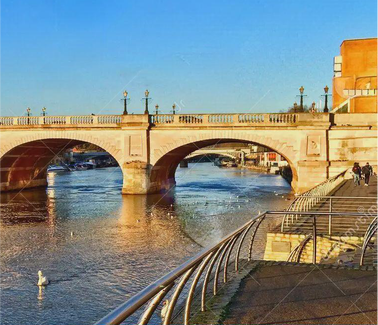 The Kingston Bridge, opened to the public in 1828 and widened in 1914, has an attractive row of iron lanterns on its southern side, cast from the furnaces of the Harris Iron foundry. Nestled into the bridge's parapet is a plaque, chronicling the bridge's rich history. Another landmark is the medieval stone and brick bridge that spans the Hogsmill, known as the Clateryngbrugge in the late 1200s. Further
The Kingston Bridge, opened to the public in 1828 and widened in 1914, has an attractive row of iron lanterns on its southern side, cast from the furnaces of the Harris Iron foundry. Nestled into the bridge's parapet is a plaque, chronicling the bridge's rich history. Another landmark is the medieval stone and brick bridge that spans the Hogsmill, known as the Clateryngbrugge in the late 1200s. Furtherdownstream, you'll find remnants of this medieval bridge, immortalised in the name of Old Bridge Street. To the north, Turk's Boatyard—family-run since 1740—still crafts items related to water, whilst the riverside is vivified by a lively array of bars and restaurants.
Walking itineraries - The banks of the river offer delightful strolls. Downstream of the Kingston Bridge, a scenic route traverses the Canbury Gardens, leading towards Teddington lock. Upstream, the Riverside Walk meanders, becoming the Queen's Promenade after crossing the Hogsmill River, nearly reaching Surbiton. Equally beautiful is the Barge Walk on the river's right bank, shadowing the vast Hampton Court Park.
KINGSTON MUSEUM
FAIRFIELD ROAD
UNDERGROUND: KINGSTON
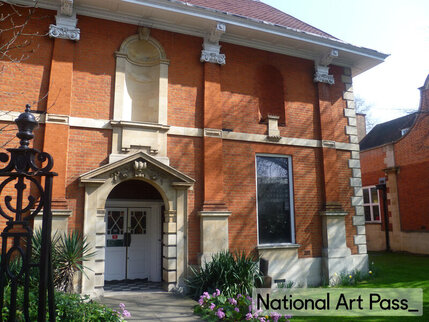 Positioned on Fairfield Park's north side is a museum, established in 1904. This institution is a trove of historical treasures, from paintings and prints to archaeological artefacts such as swords, buckles, weights, a Roman altar, and bones from the Mitcham tombs. Galleries under the title "Town of Kings" safeguard documents and images tracing the district's rich lineage and royal era. Among the treasures of Kingston is the photographic equipment of Eadweard Muybridge, a local son and a pioneer of cinematography. Muybridge had invented an apparatus that lent an illusion of motion through the use of a rotating glass disk, which he named the Zoopraxiscope. It was Muybridge himself who bestowed this inventive contraption, along with all his equipment, to the museum. The establishment also hosts a distinct art
Positioned on Fairfield Park's north side is a museum, established in 1904. This institution is a trove of historical treasures, from paintings and prints to archaeological artefacts such as swords, buckles, weights, a Roman altar, and bones from the Mitcham tombs. Galleries under the title "Town of Kings" safeguard documents and images tracing the district's rich lineage and royal era. Among the treasures of Kingston is the photographic equipment of Eadweard Muybridge, a local son and a pioneer of cinematography. Muybridge had invented an apparatus that lent an illusion of motion through the use of a rotating glass disk, which he named the Zoopraxiscope. It was Muybridge himself who bestowed this inventive contraption, along with all his equipment, to the museum. The establishment also hosts a distinct artgallery for special exhibitions. Venturing onto London Road, a continuation of Fairfield Road and near the Norbiton station, you encounter the charming Cleave's Almshouses, erected in 1669 to provide refuge for "six poor men and six poor women". The small entrance doors, painted a subtle green-grey, are framed by two windows and crowned with three round portholes.
Still on London Road stands the Lovekyn Chapel, built in 1309 by Edward Lovekyn as a site for reciting prayers for his family. Constructed of stone, it boasts large, colourful stained-glass windows and houses a magnificent organ. Today, it serves as a popular venue for weddings.
CHESSINGTON WORLD OF ADVENTURES
LEATHERHEAD ROAD
TRAIN: SOUTH WESTERN RAILWAY
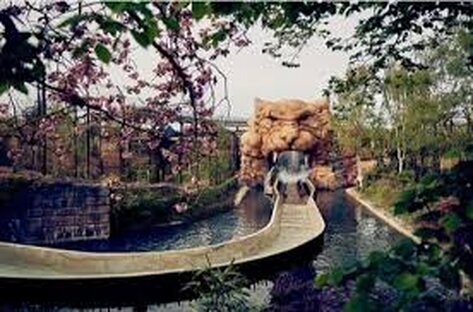 In 1931, in the surrounding grounds of an ancient mansion, Reginald Goddard fashioned the Chessington World of Adventure, an amusement park with a unique flair. Over the years, various additions and contraptions were installed. One such installation inside the mansion lends it an air of being haunted. A green trail is arranged in the park, which carries visitors from the wilderness of Asia to a marine aquarium, from a children's zoo to a monkey park and aviaries, and from a boat ride with a water plunge to a corner hosting penguins and otters. For those wishing to experience the thrill of an African journey, an overnight stay at the on-site hotel is possible. The rooms are styled after a safari in the savannah, with the roaring of lions and the thudding of gorilla chests sounding in the distance. The views from the windows offer a charming vista of the zoo. For dining, the Langata brasserie offers an intriguing menu, and the Marula bar serves refreshments.
In 1931, in the surrounding grounds of an ancient mansion, Reginald Goddard fashioned the Chessington World of Adventure, an amusement park with a unique flair. Over the years, various additions and contraptions were installed. One such installation inside the mansion lends it an air of being haunted. A green trail is arranged in the park, which carries visitors from the wilderness of Asia to a marine aquarium, from a children's zoo to a monkey park and aviaries, and from a boat ride with a water plunge to a corner hosting penguins and otters. For those wishing to experience the thrill of an African journey, an overnight stay at the on-site hotel is possible. The rooms are styled after a safari in the savannah, with the roaring of lions and the thudding of gorilla chests sounding in the distance. The views from the windows offer a charming vista of the zoo. For dining, the Langata brasserie offers an intriguing menu, and the Marula bar serves refreshments.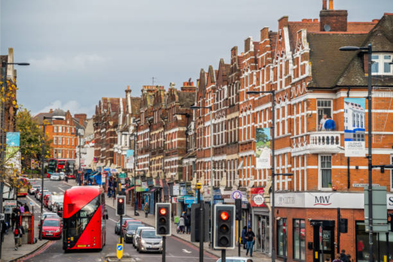 Its name, first recorded in 1062 as Lambehitha, translates to "landing place for lambs". A street in the area, Lower Marsh, serves as a reminder of the region's marshy past. From Lambeth, one can savour a splendid view of the Parliament building and Somerset House, with the dome of St Paul's and the steps of St Bride's forming a picturesque backdrop.
Its name, first recorded in 1062 as Lambehitha, translates to "landing place for lambs". A street in the area, Lower Marsh, serves as a reminder of the region's marshy past. From Lambeth, one can savour a splendid view of the Parliament building and Somerset House, with the dome of St Paul's and the steps of St Bride's forming a picturesque backdrop.In Lambeth, notable green spaces abound, among which are Brockwell Park and Brockwell Lido. Along Black Prince Road — named after the moniker for the Duke of Cornwall, whose father had gifted him the Kennington estate that this road traverses — stands a row of cottages designed by Louis de Soissons. These homes exemplify how mass housing can still be delightful.
Flanking the Lambeth Bridge are two towering obelisks, seemingly crowned with pineapples. However, in truth they are not truly pineapples but pinecones which, dating back to the Roman times, have symbolized hospitality. The resemblance in shape led to them earning their name as pineapples. This was around the time pineapples began to be imported.
LONDON NECROPOLIS RAILWAY
WESTMINSTER BRIDGE ROAD
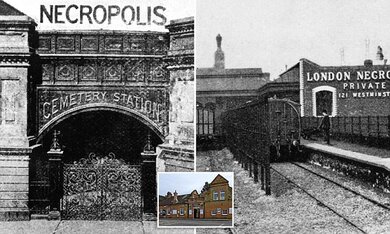 The striking red-brick building adorned with terracotta ornaments is what remains of a railway where trains once transported coffins to a pine-dotted cemetery in western Surrey.
The striking red-brick building adorned with terracotta ornaments is what remains of a railway where trains once transported coffins to a pine-dotted cemetery in western Surrey.By the mid-19th century, the London Necropolis & Mausoleum Company began offering this service to the rapidly expanding capital's populace.
Lord Onslow decided to purchase two thousand acres near Brookwood station, west of Woking, dedicated for burials.
LAMBETH PALACE
LAMBETH PALACE ROAD
UNDERGROUND: LAMBETH NORTH
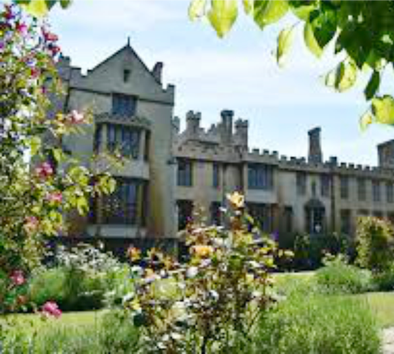 Lambeth Palace serves as the London residence of the Archbishop of Canterbury. It's among the few architecturally valuable medieval structures left in the capital, shielded by a lofty wall. To catch a glimpse of it, one should stand on the opposing bank. From the park, its two entrances are noticeable. The larger of the two, rendered in pink-hued bricks, was for coaches and wagons, while the smaller one was for pedestrians. Instead, in order to explore its interior, one might for example seize the opportunity during an exhibition in its library. Founded in 1610 by Archbishop Bancroft, it's among the country's oldest and has been continually enriched with volumes. Within its walls are approximately 1,250 manuscripts, including the 9th-century Macdurnan Gospels and the 10th-century De Virginitate by Aldhelmus, which is abundant with exquisite drawings. Also housed are the illuminations of the Lambeth Bible and the Lambeth Apocalypse from the 12th and 13th centuries respectively. A prized New Testament by Gutenberg, hundreds of early printed books, Edward VI's Latin grammar, and Queen Elizabeth's prayer book can also be found. The archbishopric registers, consisting of official deeds, provide an almost unbroken sequence from the year 1200 to the present. A section of the garden was transformed into a public park in 1900; it is easily accessible from Park Street and Carlisle Street.
Lambeth Palace serves as the London residence of the Archbishop of Canterbury. It's among the few architecturally valuable medieval structures left in the capital, shielded by a lofty wall. To catch a glimpse of it, one should stand on the opposing bank. From the park, its two entrances are noticeable. The larger of the two, rendered in pink-hued bricks, was for coaches and wagons, while the smaller one was for pedestrians. Instead, in order to explore its interior, one might for example seize the opportunity during an exhibition in its library. Founded in 1610 by Archbishop Bancroft, it's among the country's oldest and has been continually enriched with volumes. Within its walls are approximately 1,250 manuscripts, including the 9th-century Macdurnan Gospels and the 10th-century De Virginitate by Aldhelmus, which is abundant with exquisite drawings. Also housed are the illuminations of the Lambeth Bible and the Lambeth Apocalypse from the 12th and 13th centuries respectively. A prized New Testament by Gutenberg, hundreds of early printed books, Edward VI's Latin grammar, and Queen Elizabeth's prayer book can also be found. The archbishopric registers, consisting of official deeds, provide an almost unbroken sequence from the year 1200 to the present. A section of the garden was transformed into a public park in 1900; it is easily accessible from Park Street and Carlisle Street.THE GARDEN MUSEUM
LAMBETH PALACE ROAD
UNDERGROUND: LAMBETH WESTMINSTER
 The gardener John Tradescant was born in 1570, during the reign of Elizabeth I. It was a time when the island was introduced to previously unknown flowers, such as fritillaries and carnations, and plants like aquilegia, quince apples, medlars, and yucca. Among the most unusual species was the Vegetable Lamb of Tartary, a fern so named due to the peculiar shape of its roots. The Tradescant Museum, established by John and Rosemary Nicholson, who established what is now the only British museum dedicated to the history of gardening.
The gardener John Tradescant was born in 1570, during the reign of Elizabeth I. It was a time when the island was introduced to previously unknown flowers, such as fritillaries and carnations, and plants like aquilegia, quince apples, medlars, and yucca. Among the most unusual species was the Vegetable Lamb of Tartary, a fern so named due to the peculiar shape of its roots. The Tradescant Museum, established by John and Rosemary Nicholson, who established what is now the only British museum dedicated to the history of gardening.It's situated in what was once St Mary's Church. The cemetery here is the resting place for notable figures like Elias Ashmole, the antiquarian and collector behind Oxford's Ashmolean Museum, and the 18th-century boxer, John Broughton. The Tradescant family tomb resembles a sarcophagus adorned with small, dilapidated temples on its sides and crocodiles peeking out from beneath the mud. Nearby lies the grave belonging to Captain Bligh, the stern and uncompromising leader of the Bounty, whose harshness led to the famous 1789 mutiny. Today, the cemetery has been transformed into a garden, beautifully laid out with a rich variety of flowers, plants, and shrubs.
A standout section of the museum focuses on gardening tools, showcasing their varied nature. Upon exiting, one can pause for a refreshing cup of tea.
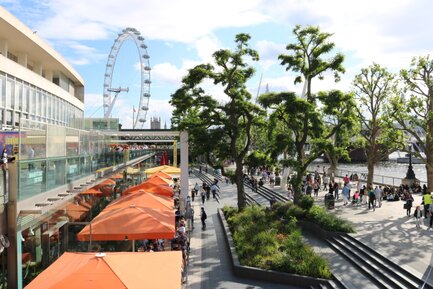 The stretch of shoreline between Westminster and Waterloo bridges is known as South Bank. Historically, this area housed markets and factories. Among them was the Coade Artificial Stone Manufactory and later, the Lion brewery. Development persisted into the 20th century until World War II. By the time the war had ended, Lambeth lay in ruins, and the riverside, which is now the South Bank, stood as a desolate, abandoned wasteland. Then, in 1951, the government chose this very location to host a festival celebrating the end of the war years. This cheerful event swiftly became an integral part of London's folklore. The festival, officially organized by the City's mayor and hence named the Mayor Thames Festival, takes place every second weekend of September between Westminster Bridge and Tower Bridge. A parade of boats becomes the highlight of the event. Visitors can enjoy films and shows, indulge in outdoor dining, take river cruises, dance in the streets, craft sculptures, and revel in music. Coinciding with the festival is the "Feast on the Bridge," featuring numerous stalls offering culinary delights. As night falls, a spectacular display of fireworks is launched from the boats, illuminating the evening sky.
The stretch of shoreline between Westminster and Waterloo bridges is known as South Bank. Historically, this area housed markets and factories. Among them was the Coade Artificial Stone Manufactory and later, the Lion brewery. Development persisted into the 20th century until World War II. By the time the war had ended, Lambeth lay in ruins, and the riverside, which is now the South Bank, stood as a desolate, abandoned wasteland. Then, in 1951, the government chose this very location to host a festival celebrating the end of the war years. This cheerful event swiftly became an integral part of London's folklore. The festival, officially organized by the City's mayor and hence named the Mayor Thames Festival, takes place every second weekend of September between Westminster Bridge and Tower Bridge. A parade of boats becomes the highlight of the event. Visitors can enjoy films and shows, indulge in outdoor dining, take river cruises, dance in the streets, craft sculptures, and revel in music. Coinciding with the festival is the "Feast on the Bridge," featuring numerous stalls offering culinary delights. As night falls, a spectacular display of fireworks is launched from the boats, illuminating the evening sky.In 1906, during the excavations that were being carried out for the construction of the new London Council headquarters, an old ferry was unearthed. This artifact now resides in the Museum of London. Near Waterloo Bridge — no longer the elegant 19th-century structure designed by Rennie that spans the Thames with five arches — one can find iron seats adorned with swans. Their folded wings serve as armrests.
THE SCOOP AMPHITHEATER
24 MORE LONDON RIVERSIDE
UNDERGROUND: LAMBETH NORTH
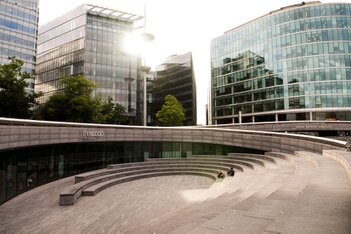 We are often accustomed to the term "scoop" in the context of a journalistic breakthrough, but of course it also denotes something one might perform with a ladle or a shovel. This dual meaning is evident in the design of the outdoor amphitheater, recessed into the ground, located in front of the City Hall. Capable of hosting eight hundred attendees, it has a vibrant schedule of free events spanning from May to October, ranging across films, concerts, and theater performances, collectively known as Al Fresco Theatre. The full name of this venue, the Scoop at More London, buzzes with music, particularly in July, while August and September feature plays. On Christmas Eve, the setting transforms for festive carols and storytelling.
We are often accustomed to the term "scoop" in the context of a journalistic breakthrough, but of course it also denotes something one might perform with a ladle or a shovel. This dual meaning is evident in the design of the outdoor amphitheater, recessed into the ground, located in front of the City Hall. Capable of hosting eight hundred attendees, it has a vibrant schedule of free events spanning from May to October, ranging across films, concerts, and theater performances, collectively known as Al Fresco Theatre. The full name of this venue, the Scoop at More London, buzzes with music, particularly in July, while August and September feature plays. On Christmas Eve, the setting transforms for festive carols and storytelling.BELVEDERE ROAD
UNDERGROUND WATERLOO
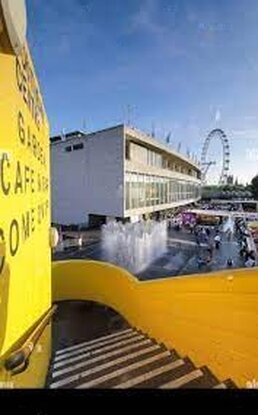 The Southbank Centre is a major arts hub that encompasses the Royal Festival Hall, the Hayward Gallery, the Queen Elizabeth Hall, and the Purcell Room. The Royal Festival Hall, located on Belvedere Road, was inaugurated on May 3rd, 1951. It was designed to achieve acoustic excellence despite its grandeur, accommodating up to three thousand attendees. This hall is the primary venue for the concerts performed by the Philharmonic Orchestra and also hosts a number of dance performances. The success of the Festival Hall spurred the construction of other similar structures, which today stand as significant examples of modern architecture, although not universally beloved. The Hayward Gallery, inaugurated in 1968, houses various temporary exhibitions, with its two floors connected by concrete staircases. The Queen Elizabeth Hall, dating back to 1967, can seat just over a thousand patrons, and offers daily concerts, spanning classical to jazz and avant-garde music. Its counterpart, the Purcell Room, is more intimate, seating 370 and primarily hosts recitals and chamber concerts. The complex also houses the National Film Theatre, now known as BFI Southbank, with its entrance nestled beneath Waterloo Bridge.
The Southbank Centre is a major arts hub that encompasses the Royal Festival Hall, the Hayward Gallery, the Queen Elizabeth Hall, and the Purcell Room. The Royal Festival Hall, located on Belvedere Road, was inaugurated on May 3rd, 1951. It was designed to achieve acoustic excellence despite its grandeur, accommodating up to three thousand attendees. This hall is the primary venue for the concerts performed by the Philharmonic Orchestra and also hosts a number of dance performances. The success of the Festival Hall spurred the construction of other similar structures, which today stand as significant examples of modern architecture, although not universally beloved. The Hayward Gallery, inaugurated in 1968, houses various temporary exhibitions, with its two floors connected by concrete staircases. The Queen Elizabeth Hall, dating back to 1967, can seat just over a thousand patrons, and offers daily concerts, spanning classical to jazz and avant-garde music. Its counterpart, the Purcell Room, is more intimate, seating 370 and primarily hosts recitals and chamber concerts. The complex also houses the National Film Theatre, now known as BFI Southbank, with its entrance nestled beneath Waterloo Bridge.Beneath the irregular pyramid designed by architect Lasdun lies the National Theatre, one of the most vibrant theaters globally. There are three performance halls: the Olivier, named after the actor who served as its first director, featuring a large open stage; the Lyttelton, which possesses a more traditional layout; and the smaller Cottesloe, dedicated to experimental productions. Various workshops are where sets are perfected and costumes prepared. The vast foyer is a lovely space to spend time, often hosting free entertainment, book stalls, a bar, and a self-service area. One can sit, read, chat, and gaze upon the river through expansive windows. The foyer's aim is to attract those who typically wouldn't visit a theater.
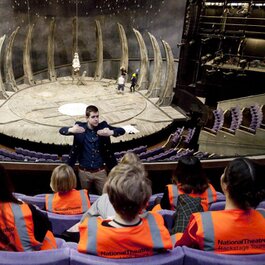 Backstage Tour - There are regular guided tours of the behind-the-scenes spaces. Visitors navigate lengthy corridors, rehearsal studios, set-painting workshops, and reach the revolving stage where scenes for upcoming acts are prepared. It's a fascinating journey.
Backstage Tour - There are regular guided tours of the behind-the-scenes spaces. Visitors navigate lengthy corridors, rehearsal studios, set-painting workshops, and reach the revolving stage where scenes for upcoming acts are prepared. It's a fascinating journey.Nestled on Belvedere Road, the majestic Shell Centre proudly reaches for the sky. Its 25-story façade is decorated with carved shells, a testament to its namesake. At its heart, a captivating courtyard fountain, crafted from layers of gleaming brass shells, allows water to cascade down. The surrounding paved expanse showcases embedded spiral-shaped ammonite shells, a nod to ancient marine life. In 1977, in honor of Queen Elizabeth's Silver Jubilee, a scenic riverside promenade was introduced. Adjacent to the vibrant South Bank complex, on the gracefully curved Bargehouse Street, stands the iconic Oxo Tower. Its eighth floor unveils a charming terrace which is home to a gourmet restaurant, offering panoramic views. A short stroll away on Waterloo Road, one can't help but admire the Old Vic's stunning brickwork contrasted by its pristine white facade. Originally inaugurated in 1818 as the Royal Coburg, this historic venue, once a hub for varied performances, has celebrated Shakespearean plays. Since 1914, it has been dedicated to exclusively presenting the timeless works of the Bard.
THE CINEMA MUSEUM
2 DUGARD WAY
UNDERGROUND: WATERLOO
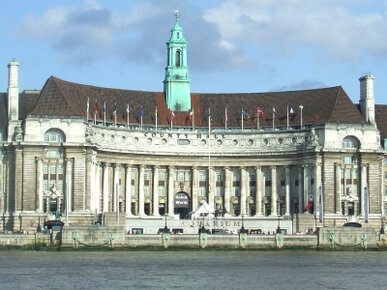 The Cinema Museum, a brainchild of Ronald Grant and Martin Humphries, proudly displays their personal collection of cinematic treasures and historical snapshots. Intriguingly, the building that now celebrates film once functioned as a correctional orphanage. It holds stories of its own, having been the childhood refuge for notable figures like Charles Chaplin and his brother during a period when their mother faced dire financial hardships.
The Cinema Museum, a brainchild of Ronald Grant and Martin Humphries, proudly displays their personal collection of cinematic treasures and historical snapshots. Intriguingly, the building that now celebrates film once functioned as a correctional orphanage. It holds stories of its own, having been the childhood refuge for notable figures like Charles Chaplin and his brother during a period when their mother faced dire financial hardships.The Cinema Museum boasts a rich tapestry of cinematic history. Within its walls, you will find an array of projectors, evocative vintage posters, flyers, and a myriad of photographs. There's a vast collection of programs, sheet music that once set the mood for silent films, an extensive library of cinema books and magazines, and naturally, countless film reels that tell tales of years gone by. The museum also houses authentic Art Deco-style seats and the nostalgic uniforms worn by theater ushers during the 1940s and 50s. In those days, instead of a paper ticket, patrons were handed a tactile token with an embossed symbol, allowing the usher to guide them to their designated section by touch alone. Among the museum's quirky artifacts are ashtrays from bygone eras and vintage cardboard containers that once held popcorn.
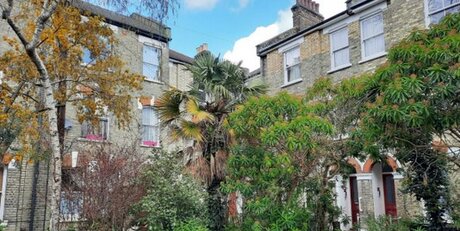 Vauxhall's narrative might draw parallels with Turin, both places of historical significance, yet often recognized mainly for their automotive contributions. The name 'Vauxhall' is thought to have evolved from a twist on the name of King John's mercenary leader, Falkes de Breauté, a notable resident of the area. The 18th century saw Vauxhall graced by its renowned pleasure gardens, a locale so famous that even the illustrious Pushkin made mention of it. This era also marked the beginning of transforming the partly marshy terrain into usable land. The Vauxhall Bridge stands adorned with bronze female figures by Drury and Pomeroy, each symbolizing different arts and crafts. The one representing architecture delicately holds a miniature replica of St Paul's Cathedral. A closer look just requires one to lean over the edge.
Vauxhall's narrative might draw parallels with Turin, both places of historical significance, yet often recognized mainly for their automotive contributions. The name 'Vauxhall' is thought to have evolved from a twist on the name of King John's mercenary leader, Falkes de Breauté, a notable resident of the area. The 18th century saw Vauxhall graced by its renowned pleasure gardens, a locale so famous that even the illustrious Pushkin made mention of it. This era also marked the beginning of transforming the partly marshy terrain into usable land. The Vauxhall Bridge stands adorned with bronze female figures by Drury and Pomeroy, each symbolizing different arts and crafts. The one representing architecture delicately holds a miniature replica of St Paul's Cathedral. A closer look just requires one to lean over the edge. Vauxhall's Victorian park, nestled on Fentiman Road, first opened its gates in 1785 and retained its original charm for nearly a hundred years. A looming threat of construction once cast a shadow over its green expanses, but timely intervention by public administration ensured its preservation. The park, with its ornate gates crafted by C. Harrison Townsend, was ceremoniously inaugurated for the public by the Prince of Wales in 1890.
THE CRICKET STADIUMKENNINGTON OVALVAUXHALL
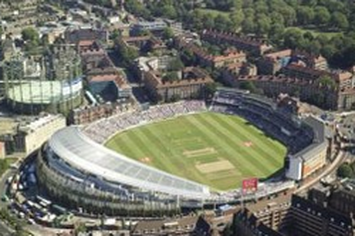 While the English often jest that one has to be native to the country to truly understand cricket, Vauxhall welcomes all to experience the sport. The venue, aptly named The Oval due to its distinctive shape, was established in 1845 on what was once a fruit orchard. This grand stadium has not only witnessed cricket but also hosted the inaugural FA Cup final on March 16, 1872, and several others until 1892. The expansive pavilion encompasses a library, café, and a fine-dining restaurant, along with exclusive rooms for club members and staff. Today, The Oval stands as a revered landmark in the cricketing world. Above the Members Entrance, a distinctive clock adds a touch of character, encapsulating the essence of this historic venue.
While the English often jest that one has to be native to the country to truly understand cricket, Vauxhall welcomes all to experience the sport. The venue, aptly named The Oval due to its distinctive shape, was established in 1845 on what was once a fruit orchard. This grand stadium has not only witnessed cricket but also hosted the inaugural FA Cup final on March 16, 1872, and several others until 1892. The expansive pavilion encompasses a library, café, and a fine-dining restaurant, along with exclusive rooms for club members and staff. Today, The Oval stands as a revered landmark in the cricketing world. Above the Members Entrance, a distinctive clock adds a touch of character, encapsulating the essence of this historic venue.In the later years of the 19th century, there emerged a novel idea to provide aerial views of matches by soaring a Zeppelin and a hot-air balloon over the playing field. Yet, despite its innovative approach, the concept never truly took off.
STRETCHERS TRANSFORMERD INTO FENCES
HARLEYFORD STREET
UNDERGROUND: OVAL
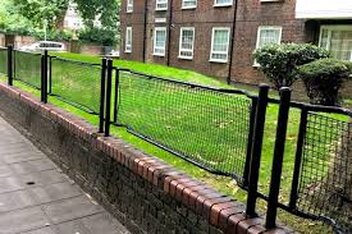 For travelers with a penchant for uncovering the capital's unique and lesser-known tales, here's an interesting snippet from history. During the harrowing bombings of World War II, a brigade of first-aid volunteers stood at the ready. The moment the sirens sitting on rooftops signaled the all-clear, these brave souls would dash to the bombed sites. Comprising frontline doctors and nurses, their mission was to administer immediate medical aid to the injured and provide help to those in distress. Minor injuries were treated right there amidst the rubble, while those critically hurt were swiftly transported to medical facilities in ambulances.
For travelers with a penchant for uncovering the capital's unique and lesser-known tales, here's an interesting snippet from history. During the harrowing bombings of World War II, a brigade of first-aid volunteers stood at the ready. The moment the sirens sitting on rooftops signaled the all-clear, these brave souls would dash to the bombed sites. Comprising frontline doctors and nurses, their mission was to administer immediate medical aid to the injured and provide help to those in distress. Minor injuries were treated right there amidst the rubble, while those critically hurt were swiftly transported to medical facilities in ambulances.When traditional stretchers were scarce, makeshift solutions like doors or planks became the order of the day. However, the official stretchers were crafted from sturdy iron, complete with elongated side poles. Post-war, with their primary purpose rendered obsolete, these stretchers found a new lease on life. Their metal frames, spaced just right, were ingeniously transformed into fences for the quaint gardens of public housing, situated directly opposite the Oval cricket ground. The brick pillars that held them were specially crafted for this purpose. Yet, a keen observer might spot a telltale sign of their original function. The "feet" that once slid beneath the stretchers' outermost pipes remain visible even today, with some bearing an almost oval contour. These pedestals stood between the stretcher and the ground, keeping them elevated.
KENNINGTON PARK
UNDERGROUND: OVAL
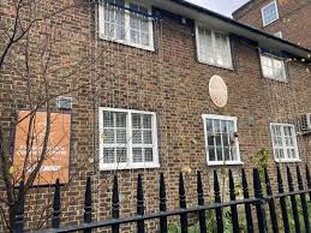 Prince Albert, renowned for establishing landmarks like the Science Museum, the Victoria & Albert Museum, and the Royal Albert Hall, also envisioned a project that's now somewhat overshadowed: the Prince Consort Lodges. Entrusting the architectural design to Henry Roberts, a visionary for the Society for Improving the Conditions of the Labouring Classes, the blueprint featured clusters of four apartments centered around a communal staircase. This pioneering housing design, termed the "model dwelling," subsequently set the blueprint for countless Victorian residences. Unfortunately, the lodgings' pricing was beyond the reach of the average worker, leading to their occupation by relatively affluent craftsmen. Presently, these historic dwellings are largely obscured by lush greenery. Yet, given that they now house the offices of the "Trees for Cities" organization, this green embrace seems rather fitting.
Prince Albert, renowned for establishing landmarks like the Science Museum, the Victoria & Albert Museum, and the Royal Albert Hall, also envisioned a project that's now somewhat overshadowed: the Prince Consort Lodges. Entrusting the architectural design to Henry Roberts, a visionary for the Society for Improving the Conditions of the Labouring Classes, the blueprint featured clusters of four apartments centered around a communal staircase. This pioneering housing design, termed the "model dwelling," subsequently set the blueprint for countless Victorian residences. Unfortunately, the lodgings' pricing was beyond the reach of the average worker, leading to their occupation by relatively affluent craftsmen. Presently, these historic dwellings are largely obscured by lush greenery. Yet, given that they now house the offices of the "Trees for Cities" organization, this green embrace seems rather fitting.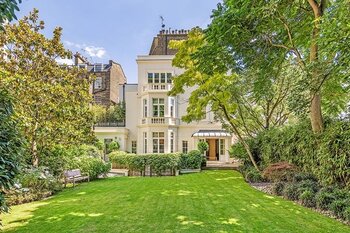 Among the notable residents was the builder Thomas Cubitt, who lived in a house within the Clapham Park Estate. The Polygon building, erected in 1792, housed a shop that sold Edward’s Soup, neatly stacked in jars within its spacious windows. Today, the premises are occupied by the Rose and Crown pub, and next door at number 4 is the Trinity restaurant, where one can choose to dine on a whole spit-roasted suckling pig or a fine roasted pig’s head.
Among the notable residents was the builder Thomas Cubitt, who lived in a house within the Clapham Park Estate. The Polygon building, erected in 1792, housed a shop that sold Edward’s Soup, neatly stacked in jars within its spacious windows. Today, the premises are occupied by the Rose and Crown pub, and next door at number 4 is the Trinity restaurant, where one can choose to dine on a whole spit-roasted suckling pig or a fine roasted pig’s head.CLAPHAM COMMON
UNDERGROUND STATION: CLAPHAM COMMON
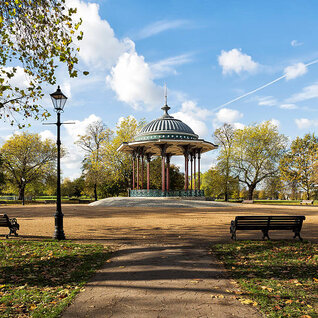 The vast green expanse of Clapham Common, a ninety-acre triangular area, is well-known. Among the houses on the northern edge, the Gilmore House, built in 1760, is particularly notable with its niches housing busts of Shakespeare and Milton. Samuel Pepys spent his later years there until 1703, as a guest of his friend William Hewer. Another of the houses surrounding the Common was for many years the residence of the widow of Captain Cook, the explorer.
The vast green expanse of Clapham Common, a ninety-acre triangular area, is well-known. Among the houses on the northern edge, the Gilmore House, built in 1760, is particularly notable with its niches housing busts of Shakespeare and Milton. Samuel Pepys spent his later years there until 1703, as a guest of his friend William Hewer. Another of the houses surrounding the Common was for many years the residence of the widow of Captain Cook, the explorer.These historic homes lend the area around the park a village atmosphere. At the same time, however, the environment becomes vibrant during concerts and outdoor performances held there. There is also a large number of restaurants and cafes, making the streets lively. On the north side of the Common stands the small Holy Trinity Church, designed in 1776 by architect Keneton Couse. The building became known as "the church of the Clapham Sect," referring to the reformers who attended it. Plaques on its facade commemorate the role its members played in the abolition of slavery.
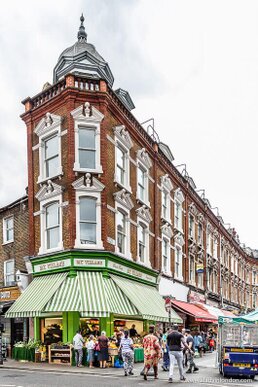 Brixton, located in the south of London, is inhabited by a multicultural community, with a quarter of the population of African or Caribbean descent. The first wave arrived from Jamaica in 1948: it was about five hundred people who arrived on the ship Empire Windrush, and for this reason, the event has gone down in history as the "Windrush generation.” 1948 was also the year when the act granting British citizenship to citizens of Commonwealth countries was passed. In the newspapers of these countries, there was an advertisement for a discounted ticket for those who wanted to rebuild their lives in Great Britain. Since the ship Windrush, which was sailing from Australia to England, was docked in Jamaica, many Jamaicans jumped on board. Although intended to be a temporary stay, the majority have remained permanently. In 1998, to mark the fiftieth anniversary of their arrival, the Windrush Square area in front of the Tate Library was officially named as such.
Brixton, located in the south of London, is inhabited by a multicultural community, with a quarter of the population of African or Caribbean descent. The first wave arrived from Jamaica in 1948: it was about five hundred people who arrived on the ship Empire Windrush, and for this reason, the event has gone down in history as the "Windrush generation.” 1948 was also the year when the act granting British citizenship to citizens of Commonwealth countries was passed. In the newspapers of these countries, there was an advertisement for a discounted ticket for those who wanted to rebuild their lives in Great Britain. Since the ship Windrush, which was sailing from Australia to England, was docked in Jamaica, many Jamaicans jumped on board. Although intended to be a temporary stay, the majority have remained permanently. In 1998, to mark the fiftieth anniversary of their arrival, the Windrush Square area in front of the Tate Library was officially named as such.It is thought that the name Brixton originates from Brixistance, which means “the stone of Brixi.” It marked the meeting point of the local community. Until the 19th century, the area was sparsely populated with mostly country homes, some of which still exist. It was only in the second half of the nineteenth century, after Brixton was connected to the city center by rail, that the population increased and the first commercial activities began along High Street, including large commercial establishments and three major department stores. There are many clubs and live music venues that stay open late. We mention the Academy, at 211 Stockwell Road, located in a building with a temple-like façade at the entrance. The Ritz cinema is housed in a beautiful building and on Sunday mornings offers film programming for children and families. Once a month, there are even screenings of films specifically for mothers and babies. The Brixton Market offers fruits, vegetables, spices, and products from the Caribbean. For example, You can find, for example, peppers used in Jerk dishes, imported directly from those islands. On the sides of the market, there are Indian and Vietnamese supermarkets, which are also interesting to visit, even just to browse.
BROCKWELL PARK
NORWOOD ROAD
UNDERGROUND STATION: BRIXTON
NORWOOD ROAD
UNDERGROUND STATION: BRIXTON
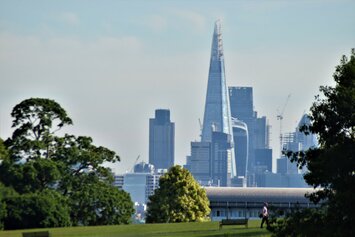 The one hundred and twenty-four acres of Brockwell Park are delimited to the north by Brixton Water Lane, to the east by Norwood Road, and to the west by Tulse Hill.
The one hundred and twenty-four acres of Brockwell Park are delimited to the north by Brixton Water Lane, to the east by Norwood Road, and to the west by Tulse Hill.Originally, it was the private park of Brockwell Hall, an austere and imposing mansion with dark matroni columns, with a white colonnade in front of the entrance and a veranda with ironwork at the south corner, built by John Blades, a wealthy glass industrialist.
In the Victorian era, a clock tower in Rajput style was added.
THE BRIXTON POUND
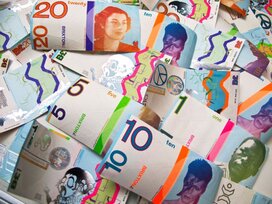 On September 17, 2009, a particular currency known as the Brixton Pound was introduced. This type of money was decided upon as part of a project called Transition Town, which permits the use of an alternative local currency to the pound sterling. The notes, which have denominations corresponding to one, five, ten, and twenty sterling pounds, feature portraits of celebrities from the neighborhood. They began to circulate in an experiment in shops, and the store owners decided to accept them the day after they were presented in exchange for goods. The goal is to boost the economy, but especially to tie as many businesses as possible to the local territory, to enhance local resources and services.
On September 17, 2009, a particular currency known as the Brixton Pound was introduced. This type of money was decided upon as part of a project called Transition Town, which permits the use of an alternative local currency to the pound sterling. The notes, which have denominations corresponding to one, five, ten, and twenty sterling pounds, feature portraits of celebrities from the neighborhood. They began to circulate in an experiment in shops, and the store owners decided to accept them the day after they were presented in exchange for goods. The goal is to boost the economy, but especially to tie as many businesses as possible to the local territory, to enhance local resources and services.Today, the beautiful villa atop a hill houses a cafe from which you can enjoy a stunning view of London and where delicious sandwiches can be savored.
Brockwell Park, acquired by the administration to be made accessible to the inhabitants of Lambeth and Southwark, was opened as a public park in 1892, thanks to the interest of Deputy Bristowe, who had also organized a fund collection for it. The unfortunate politician passed away shortly after the inaugural ceremony on June 6th. Today, the park offers a wide range of sports activities, including tennis, football, bowls, and swimming. There are also farm animals, with shows featuring ponies and horses; the park also hosts numerous craft festivals and fairs. During the Lambeth County Show, locals bring melons, turnips, giant pumpkins and compete for prizes; there are stalls selling homemade cakes, jams, floral arrangements and even a charity fishing event; bands perform in the gazebos. Many volunteers have restored the greenhouses and created vegetable gardens and orchards: the freshly harvested products are sold in the Garden Centre shop.There is an enclosed garden with a splendid rose garden. Around November 5th, you can attend the fireworks display. The most famous attraction of the park is its beautiful Lido, styled in Art Deco.
At Brockwell Park, on the first Sunday of September, the interesting Urban Green Fair takes place: there are workshops, discussions, demonstrations, conferences, and poetry readings on environmental topics, aimed at raising awareness of the issue of sustainable development.SAINT MATTHEW'S CHURCH
BRIXTON GREEN
UNDERGROUND STATION: BRIXTON
BRIXTON GREEN
UNDERGROUND STATION: BRIXTON
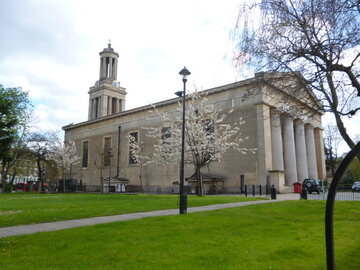 The church of St. Matthew, constructed in 1822 by the architect Porden in the neoclassical style — with a facade that resembles that of an ancient Greek temple — has been declared of architectural interest. It is one of the so-called “Waterloo churches,” built to commemorate the British victory in the Battle of Waterloo. However, over the years, as the congregation dwindled, it became too large for the number of faithful attending and was partially transformed over time into a restaurant, a bar, and a club named Brix which hosts many artistic and cultural events.
The church of St. Matthew, constructed in 1822 by the architect Porden in the neoclassical style — with a facade that resembles that of an ancient Greek temple — has been declared of architectural interest. It is one of the so-called “Waterloo churches,” built to commemorate the British victory in the Battle of Waterloo. However, over the years, as the congregation dwindled, it became too large for the number of faithful attending and was partially transformed over time into a restaurant, a bar, and a club named Brix which hosts many artistic and cultural events.In front of the church, at the crossroads of Brixton Road and Effra Road, there is an unusual funeral monument from 1825, commissioned by Henry Budd in memory of his father. It consists of three Roman altars of diminishing sizes, stacked on top of each other, with stylized palm fronds as decorative elements at the top. On the sides, there are serpents eating their own tails, which are symbols of eternity.
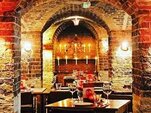 Beside them, globes are positioned that reproduce the Egyptian hieroglyph corresponding to the omnipotent Creator.
Beside them, globes are positioned that reproduce the Egyptian hieroglyph corresponding to the omnipotent Creator.Beneath St Mattheu's Church there is the Gremio Restaurant which serves tapas, seasonal ingredients and cocktails.
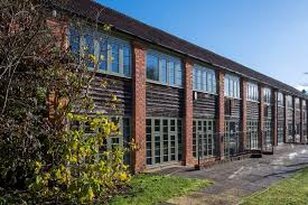 The mill in Blenheim Gardens
The mill in Blenheim Gardens Built in 1816, is one of the relics of London's past. Once, its low tower with a brick base stood in open countryside. Today, however, it is surrounded by houses that began to be built during the Victorian era. The sails were removed in 1862, to be replaced by machinery. To publicize it, a pamphlet was printed claiming that stone milling, a process recommended by the most famous doctors of the time, endowed the flour with medicinal properties. Even the poultry feed was prepared and ground in a special way by experts who had gained their knowledge through practical experience. In 1957, the mill was purchased by the public administration, which installed machinery from a mill in Burgh-le-Marsh, Lincolnshire, restored its sails, and made it functional again. The interior is available to visit upon request. Close by, at number 22 on the same street, on the corner with Bartley Road, there is the Windmill pub, which takes its name from the mill, where many musical events are organized. Unfortunately, the old building, with its Elizabethan-style façade characterized by a exposed beams, which was false but beautiful, has been demolished. The new one, white and red, is rather anonymous, but the interior is very pleasant and the live music is of great quality.
AMONG MURALS AND TROMPE L'OEIL
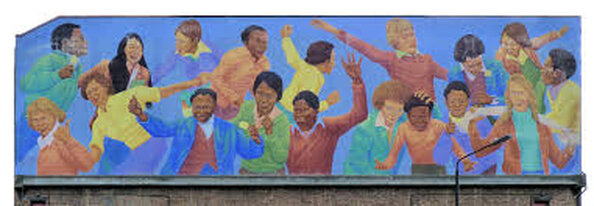 On the facades of many houses in Brixton, there are beautiful murals, some figurative, others abstract, depicting nature, politics, the community, and ideas. The Lambeth administration had overseen their creation, after the riots that broke out in 1981. We point out a few, although there are many more. There is one, in particular, that has a very beautiful meaning: it is the one painted by Stephen Pusey, on a wall of the Brixton Academy, along the Stockwell Park walk. It depicts young people of different ethnicities living together in harmony, just as it should be in schools and society. It is one of the largest murals in terms of surface area. On nearby Stockwell Road, there is another one, created by Brian Barnes with the help of school children, which also features famous figures like Violette Szabo, the British secret agent who attended schools in Brixton and is also a remembrance of those who fell in war. On the wall of the metropolitan station, there are two highly colorful murals. In one, many objects symbolizing music, theater, performances, and the market.
On the facades of many houses in Brixton, there are beautiful murals, some figurative, others abstract, depicting nature, politics, the community, and ideas. The Lambeth administration had overseen their creation, after the riots that broke out in 1981. We point out a few, although there are many more. There is one, in particular, that has a very beautiful meaning: it is the one painted by Stephen Pusey, on a wall of the Brixton Academy, along the Stockwell Park walk. It depicts young people of different ethnicities living together in harmony, just as it should be in schools and society. It is one of the largest murals in terms of surface area. On nearby Stockwell Road, there is another one, created by Brian Barnes with the help of school children, which also features famous figures like Violette Szabo, the British secret agent who attended schools in Brixton and is also a remembrance of those who fell in war. On the wall of the metropolitan station, there are two highly colorful murals. In one, many objects symbolizing music, theater, performances, and the market. In the other, located inside, exotic foods are depicted alongside a beautiful Wedgwood plate. In Glenelg Road, there is one of the most beautiful murals. It tells the story of the vanished Effra River with its fauna and flora that once populated it and of the women who worked in the Doulton factory. It covers one and a half facades of the house and the trompe l'oeil effect is extraordinary.
In Coldharbour Lane, there is a very somber mural called “Nuclear Dawn”. A large skeleton looms over the city of London, while a nuclear bomb destroys it and a sinister-colored toxic cloud descends over the houses. The Conservative MPs - whose faces have been updated during the restorations - are portrayed as being shut inside a bunker. Finally, we mention Mauleverer Road, where there are two trompe l'oeils. The first is very long and depicts horses both inside and outside the stables. The second is quite evocative, with trees bearing delicate foliage, a gazebo, a beach, and the sea in the background.

